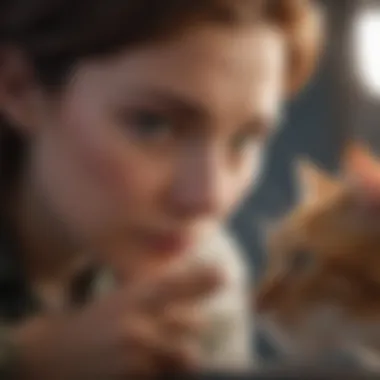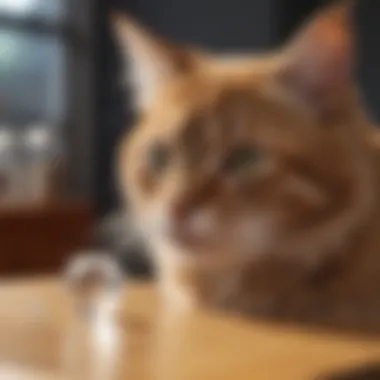Unveiling the Enigma of Struvite Crystals in Cats: A Comprehensive Guide


Pet Care Essentials
Daily Nutrition Requirements
Pet owners need to carefully monitor the dietary intake of their feline friends. Ensuring a proper balance of nutrients is crucial in warding off health complications such as struvite crystal formation. Consulting with a veterinary professional to design a suitable diet plan can be beneficial.
Exercise and Playtime
Encouraging regular physical activity is vital for cats to maintain a healthy weight and muscle tone. Engaging your pet in interactive play sessions not only strengthens the bond between the two of you but also contributes to their overall well-being.
Grooming Tips
Regular grooming plays a significant role in preventing skin and coat issues that may exacerbate underlying health conditions. Proper brushing, nail trimming, and dental care are integral parts of maintaining your cat's hygiene.
Health and Wellness Check-ins
Routine vet check-ups are essential in promptly identifying any potential health concerns. Regular examinations help in monitoring your cat's overall health and allow for early intervention if any issues, such as struvite crystals, are detected.
Introduction
Welcome to the world of feline health intricacies! In this comprehensive guide, we will delve deeply into the realm of struvite crystals in cats, shedding light on their formation, symptoms, diagnosis, treatment, and preventive measures. This article aims to equip you with valuable insights to safeguard the well-being of your beloved feline companions.
What are Struvite Crystals?
To grasp the essence of struvite crystals, it is essential to understand that these microscopic formations primarily consist of magnesium, ammonium, and phosphate. They tend to develop within the urinary tract of cats, potentially leading to a range of health complications. The formation of these crystals can be influenced by various factors, such as diet, hydration levels, and overall feline health.


Significance of Struvite Crystals in Cats
The significance of struvite crystals in feline health cannot be overstated. These crystals can cause discomfort, pain, and urinary issues for cats, impacting their overall well-being. Understanding the implications of these crystals is crucial for cat owners and veterinarians alike to ensure early detection and prompt intervention. By addressing the presence of struvite crystals proactively, we can mitigate the risk of more severe urinary tract issues and support our feline friends in leading healthier lives.
Causes of Struvite Crystals
Understanding the causes of struvite crystals in cats is paramount in ensuring the health and well-being of these furry companions. Struvite crystals, composed of magnesium, ammonium, and phosphate, can form in the urine when conditions are conducive. Several factors contribute to the formation of these crystals, each playing a significant role in the development of this common feline health issue.
Dietary Factors
Diet plays a crucial role in the formation of struvite crystals in cats. The type of food your feline friend consumes can greatly influence the p H level of their urine. A diet high in magnesium and phosphorus can increase the likelihood of crystal formation. Furthermore, the moisture content of the food is essential; dry diets can lead to concentrated urine, which is conducive to crystal formation. It is vital to provide a balanced diet that helps maintain the proper pH balance in the urine, reducing the risk of struvite crystal formation.
Dehydration
Dehydration is another significant factor that can contribute to the formation of struvite crystals in cats. When cats do not consume an adequate amount of water, their urine becomes more concentrated, increasing the chances of crystal formation. Proper hydration is crucial in preventing the accumulation of minerals that form these crystals. Encouraging your cat to drink sufficient water and providing wet food can help maintain proper hydration levels, reducing the risk of crystal formation.
Urinary Tract Infections
Urinary tract infections (UTIs) can also play a role in the development of struvite crystals in cats. Infections can lead to changes in the p H levels of the urine, creating an environment where crystals can form more easily. Cats with UTIs may exhibit symptoms such as increased frequency of urination, straining during urination, and blood in the urine. Prompt treatment of UTIs is essential in reducing the risk of crystal formation and ensuring your cat's urinary tract health.
Symptoms of Struvite Crystals
Struvite crystals in cats present a host of symptoms that play a crucial role in the detection and management of this health concern. Understanding these symptoms can aid in recognizing potential issues early, leading to prompt intervention and treatment. One of the primary indications of struvite crystals is the development of urinary issues. Cats with struvite crystals may exhibit difficulties in urination, such as increased frequency, straining, or even producing smaller amounts of urine. These urinary issues can raise a red flag for pet owners, prompting them to seek veterinary assistance.
Urinary Issues


Urinary issues associated with struvite crystals are not uncommon among cats experiencing this condition. These problems can manifest as changes in urination patterns, including frequent visits to the litter box, discomfort during urination, or even inability to pass urine. Such indications of urinary issues signal a potential underlying problem that necessitates immediate attention to prevent complications and discomfort for the feline friend.
Discomfort or Pain
Discomfort or pain is another significant symptom linked to struvite crystals in cats. Cats suffering from these crystals may show signs of unease or pain while urinating, leading to behavioral changes such as vocalization, agitation, or avoidance of the litter box. Recognizing these manifestations of discomfort is crucial as it indicates the urgency of addressing the issue promptly to alleviate the cat's suffering and prevent further complications.
Changes in Urine
Changes in urine characteristics serve as vital clues in identifying the presence of struvite crystals in cats. Such alterations may include cloudy or bloody urine, abnormal odor, or increased urine output. Monitoring these changes can aid in early detection and subsequent treatment of struvite crystals, ensuring the well-being and health of the feline companion.
Diagnosis
In the realm of feline health, the diagnosis of struvite crystals holds paramount significance, acting as the crucial gateway to effective treatment and prevention strategies. Understanding the specific elements of diagnosis equips pet owners with the necessary knowledge to safeguard their feline companions’ well-being. Diagnosis involves a meticulous process that demands keen observation and prompt action to address any potential concerns at the earliest stage.
Veterinary Examination
A cornerstone in the diagnosis of struvite crystals in cats, the veterinary examination plays a pivotal role in evaluating the overall health status of feline patients. During this examination, skilled veterinarians conduct a comprehensive physical assessment to identify any tell-tale signs of urinary issues or crystal formation. Through palpation, visual inspection, and specialized diagnostic techniques, veterinarians aim to pinpoint possible underlying causes and tailor treatment plans accordingly.
Urinalysis
One of the key diagnostic tools in detecting struvite crystals, urinalysis offers valuable insights into the urinary health of feline companions. By analyzing the composition of urine samples, veterinarians can identify the presence of crystals, assess p H levels, and determine the overall health of the urinary tract. Urinalysis serves as a non-invasive yet informative method to assess the extent of crystal formation and guide the subsequent course of treatment. It provides a comprehensive view of feline health, aiding in the accurate diagnosis and management of struvite crystals.
Treatment Options
Prescription Diets


The prescription diets specialized for treating struvite crystals play a pivotal role in feline health care. These tailored dietary plans are meticulously formulated to effectively dissolve and prevent the formation of struvite crystals in cats' urine. Rich in specific nutrients and minerals, these diets aim to create an environment in the urinary tract that discourages crystal development. By emphasizing the importance of prescription diets in managing struvite crystals, cat owners can actively participate in their pet's recovery process and ensure long-term urinary health.
Medication
When addressing struvite crystals in cats, medication serves as a vital component of the treatment regimen. From antibiotics to urinary acidifiers, medications are tailored to address the underlying causes of crystal formation and alleviate associated symptoms. Administered under veterinary guidance, these medications aid in dissolving existing crystals, reducing inflammation, and restoring urinary tract function. Understanding the role of medication in combating struvite crystals equips cat owners with the knowledge needed to support their feline friend's recovery and overall well-being.
Surgical Intervention
In cases where dietary management and medication are insufficient, surgical intervention may be necessary to address struvite crystals in cats. Surgical procedures, such as cystotomy to remove stones or urethrostomy to address urinary blockages, are conducted to eliminate urinary obstructions and restore normal urinary flow. Although surgery is typically considered a last resort, it can be life-saving in critical situations where conservative treatments have proven ineffective. Exploring the role of surgical intervention in managing struvite crystals provides cat owners with a comprehensive understanding of treatment options and the potential interventions available for ensuring their pet's urinary health.
Preventive Measures
In the realm of feline health, Preventive Measures play a pivotal role in averting potential health adversities of our beloved cats. It is often said that prevention is better than cure, and when it comes to addressing concerns like struvite crystals, this adage rings particularly true. By implementing thoughtfully devised Preventive Measures, cat owners can proactively safeguard their feline companions from the discomfort and complications associated with this common health issue. This article seeks to delve into the intricacies and importance of such measures, offering insights and guidelines for maintaining optimal feline well-being.
Hydration
Hydration stands at the forefront of feline health management, playing a crucial role in mitigating the risk of struvite crystal formation. Cats, by nature, have a comparatively low thirst drive, making them susceptible to dehydration if not provided with sufficient water intake. Dehydration can contribute to the crystallization of minerals in the urine, paving the way for struvite crystals to form and potentially lead to urinary tract issues. As such, ensuring that cats have access to fresh, clean water at all times is imperative in promoting proper hydration levels and reducing the likelihood of crystal formation.
Balanced Diet
The significance of a Balanced Diet in combating feline health issues cannot be overstated, particularly in the context of struvite crystals. A diet rich in moisture, high-quality protein, and balanced minerals is essential for maintaining urinary tract health and preventing crystal deposition. Incorporating specialized urinary care diets that promote an acidic urine p H can be beneficial in dissolving existing crystals and hampering their recurrence. By providing cats with a nutritionally sound and balanced diet, pet owners can proactively support their furry friends' urinary health and overall well-being.
Environmental Enrichment
Environmental Enrichment encompasses a holistic approach to promoting feline wellness and happiness while simultaneously aiding in the mitigation of health concerns such as struvite crystals. Enriching the living environment of cats with stimulating activities, interactive toys, scratching posts, and comfortable resting spots not only enhances their physical and mental stimulation but also reduces stress levels that can exacerbate urinary issues. A stimulating and enriching environment can help alleviate boredom and anxiety, leading to a healthier and happier feline companion overall.
Conclusion
Ensuring Feline Health and Wellness
When it comes to safeguarding the health and wellness of feline companions, a multifaceted approach is essential. Ensuring proper hydration is crucial in preventing the formation of struvite crystals, as adequate water intake promotes urinary tract health. Additionally, maintaining a balanced diet that meets a cat's nutritional needs without excessive mineral content is key. Environmental enrichment, such as providing stimulating toys and spaces for physical activity, can also contribute to a cat's overall well-being. By incorporating these preventive measures into a cat's daily routine, pet owners can support the long-term health and happiness of their beloved feline friends.







